Washington: By analyzing Antarctic ice cores, scientists have revealed the most detailed look yet at the planet’s recent climactic history, including summer and winter temperatures, dating back 11,000 years to the beginning of what is known as the Holocene, according to a study.
According to the international study, it is the very first seasonal temperature record of its kind, from anywhere in the world. The study has been published in the journal Nature.
“The goal of the research team was to push the boundaries of what is possible with past climate interpretations, and for us that meant trying to understand climate at the shortest timescales, in this case seasonally, from summer to winter, year-by-year, for many thousands of years,” said Tyler Jones, lead author on the study, and assistant research professor and fellow at the Institute of Arctic and Alpine Research (INSTAAR), University of Colorado (CU), Boulder, US.
The study also validates one aspect of a long-standing theory about Earth’s climate that has not been previously proven: how seasonal temperatures in polar regions respond to the Milankovitch theory, used to explain Earth’s ice-age cycles.
“I am particularly excited that our result confirms a fundamental prediction of the theory used to explain Earth’s ice-age climate cycles: that the intensity of sunlight controls summertime temperatures in the polar regions, and thus melt of ice, too,” said Kurt Cuffey, a co-author on the study and professor at the University of California Berkeley, US.
These more highly detailed data on long-term climate patterns of the past also provide an important baseline for other scientists, who study the impacts of human-caused greenhouse gas emissions on our present and future climate, the study said.
By knowing which planetary cycles occur naturally and why, researchers can better identify the human influence on climate change and its impacts on global temperatures, the study said.
“This research is something that humans can really relate to because we partly experience the world through the changing seasons – documenting how summer and winter temperature varied through time translates to how we understand climate,” said Jones.
Scientists around the world have long studied Earth’s past climate using ice cores gathered from the poles.
These slender, cylindrical columns of ice, drilled from ancient ice sheets, mostly in Antarctica and Greenland, provide valuable long-term data trapped in time about everything from past atmospheric concentrations of greenhouse gases to past temperatures of the air and oceans.
The West Antarctic Ice Sheet (WAIS) Divide ice core, the longest ice core ever drilled by US researchers, measures 11,171 feet, or over 2 miles, long and 4.8-inches in diameter – containing data from as old as 68,000 years ago.
Ice cores like this one are then carefully cut into smaller sections which can be safely transported to and stored or analyzed in ice core labs around the country – like the Stable Isotope Lab at CU Boulder.
For this study, researchers analyzed a continuous record of water-isotope ratios from the WAIS ice core.
The ratios between the concentration of these isotopes, which are elements with the same number of protons but different numbers of neutrons, reveal data about past temperatures and atmospheric circulation, including transitions between ice ages and warm periods in Earth’s past, the study said.
By using the high-quality ice cores from the WAIS, extremely high-resolution measurements and advances in ice core analysis from the past 15 years, the team was able to correct for the diffusion present in the data and complete the study.
“Even beyond that, we had to develop new methods entirely to deal with this data, because no one’s ever seen it before. We had to go above and beyond what anyone’s done in the past,” said Jones.
It took almost a decade to figure out the proper way to interpret the data, from ice cores drilled from many years before, the study said.
The team’s next step is to attempt to interpret high-resolution ice cores in other places – such as the South Pole and in northeast Greenland, where cores have already been drilled – to better understand our planet’s climate variability.
“Humans have a fundamental curiosity about how the world works and what has happened in the past, because that can also inform our understanding of what could happen in the future,” said Jones.
-PTI






































